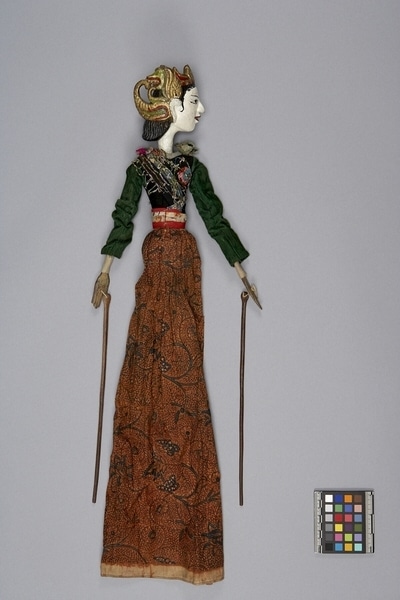Rod Puppet Item Number: Ib291 a-c from the MOA: University of British Columbia


Description
Three-dimensional female puppet: large head (part b) fits into body with jacket and skirt (part a), and a control rod (part c) with a long shaft passes through the body and fits into the neck of the figure's head. The body has jointed arms, each with a long controlling rod attached. The figure has a white face with slit-shaped eyes positioned forward. Small, straight nose. Red dot at centre of forehead, red lips. Head bending forward. Metal cylinder at base of neck. Headdress consists of green and gold painted jamang, sumping and lungsen. Clothing consists of close-fitting jacket of black cloth on torso and green corduroy sleeves, diagonal beaded band of black and floral patterned material on chest with multicoloured glass beads, red and multicoloured floral waist band, and brown and black batik patterned skirt. Hands held flat with all fingers held together and gold paint residue. Hand at figure's left is straight, hand at figure's right curves outward slightly.
History Of Use
Javanese puppetry as an art form probably developed by the 11th century. The three-dimensional wooden wayang golek puppets of western Java, which are to be distinguished from the earlier and more sacred wayang kulit shadow plays puppets or other forms, appeared during the 16th century. Originally the plays depicted Javanese mythology, but after the Indian conquest of Java the Hindu epics, Ramayana and Mahabharata, were incorporated into the cycles, which comprise about 200 plays. An individual or group hires a dalang (puppet-master) to celebrate important occasions. The performances often last all night and are generally presented in three acts, with vocal and instrumental accompaniment. The individual plays vary widely in detail but usually involve conflict between good and evil. They serve a moral and religious purpose, and more recently, one of political commentary. Each puppet's character is represented by its appearance and placement onstage; protagonists with strong elements of good are placed to the right, antagonists of violent or evil nature to the left. Topeng Budaya appears in both the Mahabharata and the Ramayana play cycles, although she takes no part in the wayang other than in the prologue. Her role is obscure, perhaps a supporting character.
Cultural Context
Theatrical performance.
Iconographic Meaning
Close-fitting clothing and a batik skirt indicate a wealthy, refined character of the nobility. A white face symbolizes youth and innocence; her beauty, fine features, and humbly posed head are additional positive attributes. Headdress with sumping and jamang worn exclusively by the nobility and deities. Posed hands considered elegant or pious. White face, small features, short hair and jamang are characteristics of Topeng Budaya, a member of the nobility but not a queen or princess.
Item History
- Made in Java, Indonesia
- Owned by Tradewind Antiques before March 15, 1983
- Received from Museum of Anthropology Shop Volunteers (Funding source) and Tradewind Antiques (Seller) on March 15, 1983
What
- Name
- Rod Puppet
- Identification Number
- Ib291 a-c
- Type of Item
- puppet
- Material
- wood, paint, cotton fibre and glass
- Manufacturing Technique
- carved, painted, machine sewn and strung
- Part B
- height 14.0 cm, width 7.0 cm, depth 9.2 cm
- Part C
- height 30.5 cm, width 2.3 cm, depth 2.2 cm
- Part A
- height 57.5 cm, width 10.0 cm, depth 5.0 cm
Who
- Culture
- Sundanese
- Previous Owner
- Tradewind Antiques
- Received from
- Museum of Anthropology Shop Volunteers (Funding source) and Tradewind Antiques (Seller)
Where
- Holding Institution
- MOA: University of British Columbia
- Made in
- Java, Indonesia
When
- Ownership Date
- before March 15, 1983
- Acquisition Date
- on March 15, 1983
Other
- Condition
- fair
- Accession Number
- 0886/0025 a-c